A meta-analysis investigation to determine the outcome of aspirin on cancer occurrence and reoccurrence
Abstract
Cancer is increasingly attracting the attention of the physicians throughout the world due to its
extensive invasion in the human body. The death toll is considerably uprising due to the fatal nature of this disease on the human body. Cancer may be designated as a disease which is associated with the abnormal division of the cells and proliferation of those cells in an uncontrolled manner. The tissues and blood vessels are attacked by these abnormal cells which is responsible for aggravating the situation. The pathogenesis of cancer is arising from the uncontrolled lifestyle, excessive intake of alcohol and tobacco as well as exposure to the hazardous chemical as well as natural environment. Apart from the genetic inherence, the viruses also play a part in inducing this disease in the human body. The treatment of this disease mostly uses the Aspirin drug which is most suitable for the breast and colorectal cancer. In the present research Meta analysis and linear regression has been accomplished as well as alternative hypothesis has been established.
Chapter 1: Introduction
1.1 Introduction
Since the inception of Aspirin in the medical field, its several uses have been recognized. As apparent, among the different medicinal roles as well as complex mechanisms of the actions that has been identified over the years; the latest one is the role of Aspirin in the prevention of cancer (Stacey, 2013). As a matter of fact, the incidents of cancer as well as the rate of mortality due the cancer are considerably decreased after the incorporation of aspiring in the field of cancer treatment. However, the duration that should be given to a cancer patient suffering from this fatal disease is minimum five years. As evident from the fact the intake of Aspirin is specially benefactor for those cancer patients who are suffering from the gastric, colorectal and esophageal cancers (Heim and Mitelman, 2015). Besides this, it has been found from the previous researches that daily consumption of this life-saving drug is beneficial for preventing the occurrence as well as reoccurrence of this life-threatening disease. Additionally, the utility of this drug is also visible in case of the prostate, breast and lung cancers. However, apart from its advantages, aspirin consumption is associated with some disadvantages also on the overall health of a patient (Rainsford, 2016).
In the present chapter of this research report, the researcher has taken into account the research questions as well as aims and objectives attached with this research. In addition to this, the present chapter is being able to focus light on the illustration of cancer and the characteristics of a cancer cell. Apart from that, the present chapter has been able to enlighten the mode of action as well as description of the working of aspirin in case of the cancer diseases.
1.2 Research question
The basic question that is associated with this Meta analysis investigation is as follows:
Is the drug Aspirin is capable enough to prevent the occurrence as well as reoccurrence of the cancer disease? In addition another question that the research deals with is that what class of cancer aspirin has effect either Benign or Malignant cancer?
1.3 Aim and objective of the research
The main aim of this current meta-analysis is to establish the efficacy of Aspirin in the diagnosis of cancer. On the other hand, the objective that is associated with this research is to find out the types of cancers that are mostly cured by the consumption of Aspirin.
1.4 Illustration of cancer and the characteristics of a cancer cell
Cancer may originate in the human body in various forms. The rectal and colon cancer, breast cancer and bladder cancers are very much familiar in the present global scenario of this disease. Apart from that, mankind is much familiar to the endometrial cancer, kidney cancer which is actually affected in the areas of renal pelvis and renal cell and leukemia. Not only is that, in now-a-days, the lung cancer, and pancreatic and prostate cancer melanoma also proved to be fatal for the human being. Among the men, colorectal, lung and prostate cancer is very common whereas, women are mostly affected with lung, colorectal and breast cancer. The children are also prone to the some severe types of cancers such as brain tumors, lymphoma and leukemia (Burr, Hull and Subramanian, 2016).
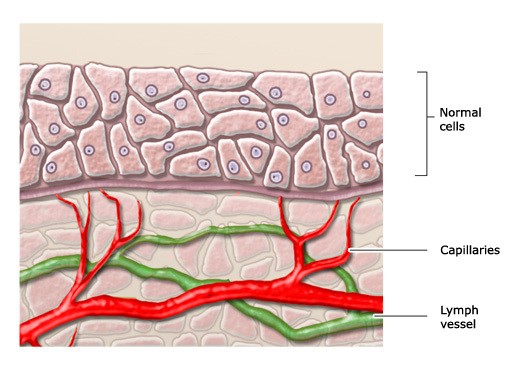
Figure 1.1: Normal cells
(Source: Rainsford, 2016)
Cancer can be defined as a cellular condition arising due to extensive mutation in the cellular genome such that the cell loses it normal characteristics and starts to show abnormal growth and behavioral nature. The changes leading to cancer are mostly in the signal transduction pathway and apoptotic pathway which are either over expressed or are repressed. Abnormal cell formation is due to the damaged DNA of the human body which is caused due to the irreparable damage to the p53 gene called the guardian of the genome as well as the p21 gene (Seyfried and Shelton, 2010). Such condition arises due to the fault cell cycle checkpoint which has lost their ability to restrict the cell with damaged DNA. In addition it has been noted that telomere mutation is also a reason for the organization of cancer the cells do not trigger the signal for apoptosis. In addition to this the over expression of growth factors such as Ras, myc and Rho are the reasons behind cancer. This over expression is a reason for the mutation due to the carcinogenic promoter and inducers present in the environment which convert a proto-oncogene to oncogene (Linehan, Srinivasan and Schmidt, 2010). The lymphatic cells are responsible for restricting these abnormal cells to the fewer numbers. When the division of these cells is uncontrollable by the body immune system, then growths or lumps are visible in the body parts which are actually known as the tumors. One of the type of these tumors is the malignant tumors which causes the cancer by spreading of the abnormal cells into the peripheral tissues. This action is followed by the destruction of the surrounding tissues which, in turn, facilitates the growth of the other tumors (Marcus, 2011).
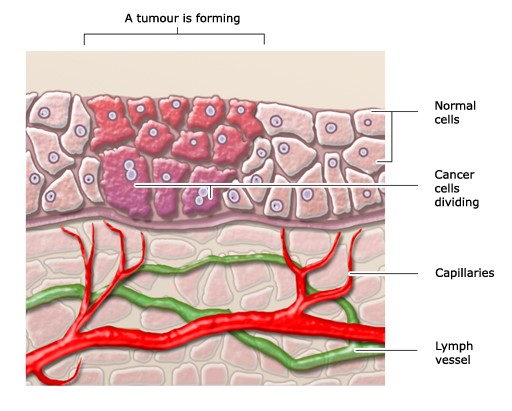
Figure 1.2: Carcinoma cancer cells
(Source: Heim and Mitelman, 2015)
As matter of fact, when the cancer cells starts to be replicate to be replicate, the normal behavior of the cells is absent. The cells are actually unable to stop the replication and division process due to their long telomere and their ability to stop apoptosis due to the increase in the anti-apoptotic proteins such as BCL-2 (Lema, Foley and Hausheer, 2010). Additionally, unlike the normal cells, the cancer cells are seldom found to be sticking with one another as they lose their ability of contact inhibition. Therefore, the breaking as well as the growing process is quite easy for the cancer cells. These cancer cells are observed to be moving through the lymphatic systems and started to be growing in other parts of the human body. In reality, the cancer cells has their own blood vessels by virtue of which the extra oxygen, hormones and glucose are supplied to the tumors and they keep growing and get bigger in size (Diehl, 2012). The cancer cells impart a special mechanism called angiogenesis were in lead to generation of new blood vessels for receiving nutrients. The magnitude of the rapidness of the growth of the cancer cells are closely related to a a signal transduction protein called the vascular endothelial growth factor or the VEGF. VEGF largely regulates the pathological as well as the physiological angiogenesis (Linehan, Srinivasan and Schmidt, 2010). Thus, creation of a vascular supply system is observed to be a commendable critical factor that is responsible for catalysing the metastatic growth of the malignant tumors. This action is followed by the invasion of the cancer cells in the peripheral tissues and is termed as invasive cancer.
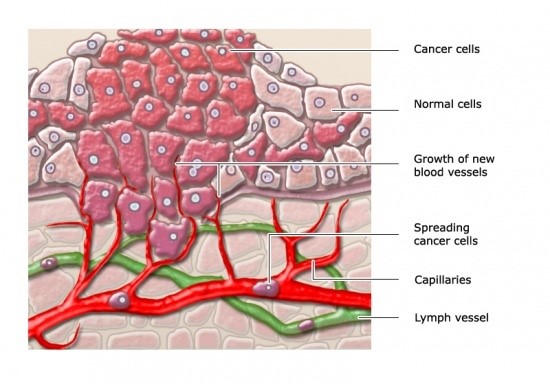
Figure 1.3: Invasive cancer cells
(Source: Stacey, 2013)
On the other hand, when the malignant tumors are contained within a specific area as well as not intended to be sprayed over the peripheral tissue, it can be termed as carcinoma in situ. This type of cancer cells or the tumors are intended to be lying quietly in a specific area and less likely to harm the human body. Apart from that, another case is that the active tumors enter the lymphatic systems or the blood stream of the human body followed by the movement to other parts of the body in order to start the process of creating tumor cells all over the body parts. This situation is called as the secondary or the metastatic cancer (Rothwell et al. 2012).
The cancer cells in the human body are organised with some special features. For example, unlike the normal cells, the cancer cells do not need to have any substratum for the growth. Besides this, proliferation is a normal feature in the cancer cells which, in turn, helps them to grow rapidly (Fowkes, 2011). Moreover, in the multinucleated cells of cancer, the contact inhibition is absent. Another special characteristic that is worthy of mentioning here is that the cancer cells are least bothered about the outside sources of growth factors such as the nutrients like vitamins which are needed for the growth of the normal cells (Rothwell et al. 2012). This is the main factor that accelerates the synthesis of the cancer cells rapidly is and is related to the de novo synthesis process. Thus, outer sources of the nucleotides are not need in this process which facilitates the growth of the cells much more rapidly than the normal cells. On the other hand, the cancer cells rely more on the de novo pathway rather than the salvage pathway because they rely on glucose and not on the vitamins for the nucleotide biosynthesis (Linehan, Srinivasan and Schmidt, 2010).
1.5 Mode of action and description of the working of Aspirin
Aspirin is believed to be a common household drug and chemically known as the acetylsalicylic acid. Although the basic application of this useful drug is in the anti-inflammatory treatment, however, various newer approaches of treatment by the application of this drug are also discovered by the scientists. As evident from the fact, the ever-ending therapeutic repertoires of Aspirin has been enlightened in the field of the cancer treatments. In the previous few years, it has been explored that the Aspirin drug is extremely suitable for the treatment of colorectal, breast and esophageal cancers. In addition to this, its application is also beneficial in cases of the lever, skin, lung and prostate cancers. The risk of all the types of the cancers are reduced many folds with the regular intake of the drugs composed of the Aspirin (Alfonso et al. 2014).
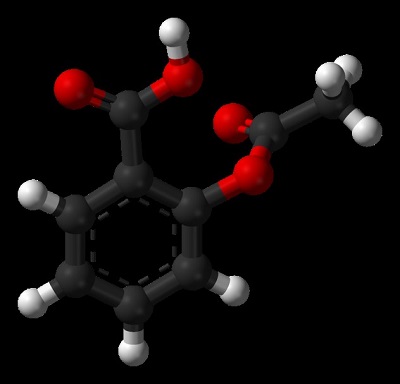
Figure 1.4: Chemical structure of Aspirin
(Source: Rainsford, 2016)
The mode of action of this drug on the cancer cells can be described on the basis of the COX-dependent procedure. The Aspirin irreversibly acetylates as well as inactivates the COX or the cyclooxygenase enzyme. The cyclic endoperoxides, which is actually responsible for forming prostaglandins, thromboxanes and prostacyclins from the arachidonic acid, are believed to be responsible for the division of the cancer cells and these cyclic endoperoxides are formed with the help of the COX enzymes. The uniqueness of Aspirin in this context may be states as that Aspirin is able to inactivate both the isoforms of the COX enzymes namely COX-1 and COX-2. Thus, the suitability of this non-steroidal drug is that it ensures antipyretic, anti inflammatory and anti analgesic effects on the affected human body parts by cancer (Alfonso et al. 2014).
The COX-induced mechanism is that Aspirin under this mechanism induces apoptosis as well as inhibits angiogenesis which are the main two reasons of the proliferation of the cancer cells. Aspirin has a potential to affect the metabolism of the arachidonic acid. In this process the COX-1 is inactivated and the COX-2 is induced with the strategic acetylation of the serine residues. Aspirin and its counterpart salicylate affect the COX-2 enzyme expression. On the other hand, Aspirin along with the sodium salicylate is responsible for decreasing the synthesis of the proinflammatory prostaglandins by virtue of which the reduction of the COX-2 gene transcription is enabled. Besides this, the inhibition of the cyclooxygenase enzyme potentially increases the AA enzyme level (Alfonso et al. 2014). This, in turn, is facilitating the conversion of the sphingomyelin to the ceramide this ceramide is believed to be the good mediator of the apoptosis. Apart from that, the platelet functioning is also affected by the Aspirin through the inhibition of COX. As a matter of fact, most of the cancer patients are observed to have an increased level of platelet activation which, in turn, is responsible for the progression of the cancer and metastasis. Thus, Aspirin is extremely beneficial to prevent the progression of the cancer in the human body (Thun, Jacobs and Patrono, 2012).
Chapter 2: Literature Review
2.1 Introductions
In the present chapter of this research report, reasons for occurrence of cancer and the pathogenesis attached with this disease has been delineated. In addition, the present chapter has potentially taken into account the physiological indications of cancer. The diagnostic procedures of cancer have also been included in this chapter. Not only that, the inducers and promoters in case of cancer as well as the epigenetic and the viral causes of cancer have also been added in this literature review chapter. Besides this, this literature review has also been able to incorporate the epidemiology associated with this life-threatening disease as well as the involvement of the drug Aspirin in addressing that disease. In this context, the chemical characteristics of Aspirin as well as the advantages and disadvantages of utilizing this useful drug in the treatment of cancer has been included in this part of the research report. Moreover, effectivity of Aspirin in treating the cancer is also added in this literature review chapter.
2.2 Reasons for the occurrence of cancer and the pathogenesis associated with it
According to the viewpoint of Rumyantsev (2010), the cancer is originated from an individual somatic cell which has an accumulation of multiple deoxyribonucleic acid mutations in the genes. These genes are supposed to be controlling the proliferation as well as the cycle of the cell. Therefore, it can be said that the disease cancer arises from the proliferation of the cells which actually leads to the creation of a maternal tumor. As opined by Seyfried and Shelton (2010), the maternal tumor as originated is subsequently spread outside the sphere of the primary site for serving the purpose of the formation of the daughter tumor cells in various distant locations of the human body. This overall matter is known as the metastasis which is actually the outcome of the defects in the DNA. In other words, the cells of the human body become cancerous because of the accumulation of the defects in the DNA which, in turn, is responsible for the out-of control growth of the cancer cells as well as invasion of those cells in other human tissues. Certainly, as per the comment of Rumyantsev (2010), various causes are persistent for facilitating cancer disease in the human body. For example, genetic defects that are inherited are definitely a potential cause for the origination of cancer in mankind. For instance, BRCA1 as well as BRCA2 are two common genetic defects that are inherited. In addition to this, several types of viral infections along with the environment factors such as opened to the excessive air pollution may cause cancer for mankind. Apart from that, choosing poor lifestyle such as heavy alcohol consumption and chain smoking or tobacco consumption is also able to damage the DNA and lead potentially to this life-risking disease. In addition to this, as per the opinion of Seyfried and Shelton (2010), frequent exposure to the toxic materials such as lead, asbestos, nickel and cadmium may lead to the cause of the cancer. Ionising radiations involving UV rays from sunlight and X-rays from the potential sources of emission may also bring the scope of attack by this life-risking disease. Not only that, several pathogens human papillomavirus or the hepatitis B and C viruses are being able to cause cancer for the mankind. As per the statement of Burrell et al. (2013), when the cells are severely damaged and are unable to repair that damage, a so-called programmed apoptosis or the cell death is happened. This activity is followed by abnormal growth, division and spread of the cells unlike the self-destruction of these damaged cells.
As per the opinion of Rumyantsev (2010), the human body that is affected by the cancer, there is the coexistence of two cell clones which have the similar origin. These cell clones is generally found to be exhibited opposite predispositions which is ultimately facilitating the development of the malignancy of the cells. The cloning cells that have the potential to cause cancer generally located in a distant area. As a matter of fact, initially the size of these cloning cells is observed to be small with variant of sizes. According to the statement of Choe et al. (2010), these cloning cells have the tendency of dispersion in the different parts of the human body. As evident from the fact, the adaptive immunity of the body system is unable to eliminate this allelic clone and thus, it is not actually allien in\\over the whole lymphatic system. This implies that the evolution of the cells that are originating the cancer is happening prior to the postnatal ontogeny. Not only are that, the dispersion of the subpopulations attached with this cloning cells in the peripheral region of the body also occurred in this Assignment.
2.3 Physiological indications of cancer
As per the opinion of Burrell et al. (2013), the signs and the symptoms that are associated with this life-threatening disease may vary depending on the type of the cancer. In other words, the location of the cancer cells and the spreading nature of the cancerous cells are the main factors that influence the symptoms of this disease. For instance, the breast cancer is characterized by the lump locations in the breast. On the other hand, when there is a sign of pain in the breast, it may be said that it is arriving towards the metastasis stage of this disease (when the spread of the cells is up to the bones). Lung cancer may have the symptoms such as the indication of extreme fatigue whereas, seizures is the symptoms for the brain cancer. However, the cancer in some cases cannot be characterized or detected with the help of the prior symptoms. In such cases the signs are only revealed when the cancer is in the advanced stage. As opined by Lema, Foley and Hausheer (2010), people may have the indication of cancer when there is change in the bladder or bowel habits. In addition, if a sore throat is not healing for a prolonged time or if there is unusual bleeding or oozing in any part of the body, this may indicate that the person may have the attack of this disease in future. Not only that, chronic indigestion or difficulty in swallowing the food as well as hoarseness and nagging cough may also indicate the chance of having cancer. In addition to this, any obvious change that is visible in the form of the size, shape, color or thickness in the part of a mole or a wart can be able to identify the scope of cancer.
As per the comment of Burrell et al. (2013), there are some other indications also that may say that the person is vulnerable to the cancer disease. For example, sudden appetite loss or abrupt weight loss as well as persistent nausea, fatigue or vomiting may indicate the future attack of this disease. Apart from that, recurring infections that cannot be cured with treatment or low-grade fevers that is persisting should also alarm a person about this disease. Besides this, a person should also consult an oncologist when there is a persistent newer type of pain in any parts of the body which is steadily worsening and aggravating the condition of the body.
2.4 Diagnostic procedures of cancer
Cancer is fatal for the human being and this disease can spread rapidly all through the human body. As evident, cancer can be recognised as the second leading disease that is causing death to the human beings across the globe. However, the unputdownable advancement of the clinical practice in the last few decades has been able to increase the rate of survival from this life-threatening disease. Various diagnostic procedures are followed by the oncologists to identify this disease. The first one is of Assignment the medical history analysis and the physical exams. Specifically, the history associated with the symptoms is considered to be the first step of cancer diagnosis (Thun et al. 2012). Presence of any tumor or lump, any abrupt change in the coloration of the skin or the unusual enlargement of any organ is basically observed by the physicians. Clinical tests, as for example, blood and urine tests and imaging tests such as bone scan, CT scan, PET scan and MRI are observed to be of utmost usefulness for the oncologists. In most of the cases, the tests are ordered by the cancer caregivers based on the type as well as location of the cancer in the body. As a matter of fact, tests related to the total blood count and the electrolyte levels are of extreme benefit for primary detection of the cancer diseases. Apart from that, imaging studies are common measuring tools that help oncologists vividly to detect any abnormality present in any body part. As for example, MRI scans, CT scans and X-ray as well as ultrasound is prioritised by the physicians. Additionally, endoscopy is also a suitable tool for measuring any abnormality in the human tissues such as in the tissues of bronchi, throat and intestinal tract which may perhaps be cancerous (Chan and Cook, 2012).
Radionuclide scanning is a breakthrough invention of the medical science that may be potentially utilised in the field of detection of the cancer in the lymph nodes and in the bones. However, the previously told tests are good for detecting the localised abnormalities in the human body parts, virtually; biopsy is the technique which helps in the definitive treatment in all types of cancers. In this technique, a tissue sample is taken from the cancerous zone and examined as well as analysed thoroughly with the involvement of the pathologists. As a matter of fact, surgery is also helpful in the treatment and cure of cancer if and only if the tissues that are affected by the disease is removed in the meantime of going through the biopsy process (Dossus et al. 2010). Not only that, biopsy is also proved to be enough fruitful in detecting and diagnosing the stage of the cancer. Thus, by virtue of the biopsy report, the clinicians can predict the extent to which the cancer has progressed in the body of the patient; more specifically, biopsy helps enormously to identify whether the cancer is of the malignant standard or the benign standard. Not only that, the stage of the cancer, whether it is in the early or in the advanced stage may also be detected via this tool (Axelrad et al. 2016).
As evident from the facts, staging is of utmost importance for the doctors to mitigate the risk of cancer. By virtue of this step adopted, the oncologists ensure the proper decision making regarding the most efficient therapeutic protocols that enables them to estimate the overall prognosis in that specific case of cancer. Nevertheless, the type as well the stage of the cancer is the ground based on which the cancer treatment is proposed by the doctors. However, most of the cancer treatments can be categorised into several components such as chemotherapy, surgery, radiation therapy or the combination of all these. In palliative therapy, which is actually the process of treatment under which the disease symptoms are partially reduced although the patient is not curable, the similar treatment strategies are followed by the doctors. The terminally ailing cancer patients are treated with this palliative therapeutic approach. Anti Nausea medication and pain medication are also viable in this context of the palliative therapy (Choe et al. 2010).
2.5 Inducers and promoters in case of cancer
Cell abnormalities which may further cause for the incorporation of cancer risk in the human body may have the unknown origins as well as the known origins such as lifestyle as well as environmental triggers. Additionally, some special kinds of the cancer are developed from the genetic makeup of a person. However, combination of these factors is also visible to be originating the sources of cancer in human kind (Stacey, 2013). Some likely candidates in this regard that is suitable for initiating cancer alone as well as in concert in collaboration with other causes may be enlisted as follows.
Genetics: Human genes are supposed to be the inducers of various types of cancers. For example, ovarian, breast, colorectal, skin and prostate cancers are induced by the human oncogenes.
Ionising radiation: Ultraviolet rays coming out from the sunlight or the rays that are coming from the radioactive materials such as Uranium and radon are proved to be potential sources of inducing oncogenes in the human body. Apart from that, X-ray-emitting sources as well as sources of radiation from the alpha, beta and gamma rays are also believed to be responsible inducing cancerous genes in human body parts (Heim and Mitelman, 2015).
Exposure to the chemical or toxic compounds: Frequent exposure to the chemical or toxic environment due to the need of the lifestyle may be recognised as the potential promoter of the cancer disease. Thus, environments loaded with chemically toxic compounds such as benzene, nickel, asbestos, cadmium and tobacco as well as cigarette smoke (composed of the carcinogenic toxins and chemicals) is believed to bring in the scope of cancer.
Pathogens: Various harmful viruses such as the HPV, EPV, KSHV and hepatitis viruses are proved to be responsible agents that are promoting the causes of cancer in mankind.
Other promoters: There are several other promoters that may have the capability itself to promote the activities of the induced oncogenes in the human body. As for example, red meat such as pork and beef are supposed to be high-risk agents in this category. Apart from that, processed meats are also placed in the top of this list as the carcinogenic agents. Another point of view is that the obesity, chronic inflammation as well as hormones used in the replacement therapy are also supposed to be suitable for promoting the advancement of the activities of the oncogenes in the human body (Rainsford, 2016).
2.6 Epigenetic and viral causes of cancer
In the present scenario of the global changes from the perspective of the epigenetic landscape is apparently the hallmark of the cancer. The initiation along with the progression of this disease is realized to be associated with the genetic abnormalities. Additionally, genetic alterations are also playing a role in this context. The recent evolution of the stem cell therapy in the diagnosis and treatment of this disease has revealed that each and every components attached with the epigenetic machinery including histone modification, DNA methylation, nucleosome position along with the non-coding RNAs have played a vital role in inducing oncogenes in the human body. All these activities are collectively known as the reprogramming of human epigenome which is actually leading to the tumorigenesis (De Carvalho et al. 2012).
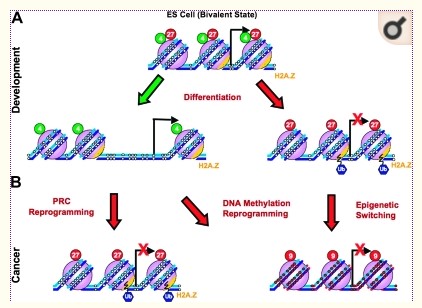
Figure 2.1: Epigenome reprogramming
(Source: Rainsford, 2016)
As a matter of fact, both the histone modification and the DNA methylation work collaboratively which, in turn, is capable to alter the overall expression of the gene during the tumorigenesis. This is actually a silence mechanism and the undermine principle of this mechanism is that combined effect of these two induces the chance of formation of the rigid chromatin state. This chromatin state is repressive in nature and resulted in the reduced magnitude of the cellular plasticity. In cancer, the target polycomb genes are replaced potentially by the methylated DNA by the de novo method (Kaneda et al. 2012).
On the other hand, as per the statement of De Carvalho et al. (2012), the contribution of the cancer due to the viruses is significant and 15% of the worldwide cancer patients are attributed to the viruses (Chiba et al. 2012). Both the DNA as well as the RNA viruses is being capable to induce and promote cancer in human being. EBV, HPV, HHV-8 and hepatitis B viruses are the DNA viruses that have the ability to promote oncogenes in the human body (Zhao et al. 2010). On the other hand, hepatitis C and HTLV-1 has the potential to disturb the immune system of the human body by the incorporation of the oncogenes. The human tumor viruses are considered to be belonging from a discrete group. All the aforesaid viruses possess different genomes and life cycles. Not only has that, the virus families attached with these viruses had the enough potential to aggravate the situation of a cancer patient. The activities of these viruses are actually a slow process. Therefore, the overall pathway from the infection by the virus to the tumorigenesis is slow as well as an inefficient process (Stacey, 2013). As evident from the fact, minority of the total infected individuals’ worldwide advances to the malignant stage of cancer. Not only that, the progress is visible after a prolonged time after the primary viral infection. However, all this viruses has the ability to advance this disease from the benign stage to the malignant stage with the cooperation of other additional events as well as several host factors such as somatic mutations, immunosuppression, and genetic predisposition along with the possible exposure to the carcinogens (Heim and Mitelman, 2015).
2.7 Epidemiology of cancer
The epidemiological studies of the cancer has revealed the fact that along with various inducers such as the genetics and the viruses which are partially inherited, the present lifestyle of the human being to survive in this competitive world has manifested many folds in the involvement of this fatal disease aggressively in the human being. In this context it is worthy of mentioning that the gender, age and economic status of people are the strong determinants apart from the genetic viewpoints of the prevalence of this life-threatening disease. Both the mortality and morbidity rate from this disease is quite high than other diseases and actually cancer is leading the table of mortality with a second position all over the world. The poverty of the under-developed countries is quite high which resulted in the malnutrition. That induces the scope of promoting the scope of cancer by the involvement of several harmful viruses (Mesri et al. 2014). Apart from that, the occupational needs are the serious matters that are playing a good role for bringing in the cancer hazards to the human being. In the developing countries, in order to maintain a sustainable life, people are not worried at all to engage in the hazardous occupations such as employment in the chemical industries. The environment of these industries are under the per scores and several harazardous chemical substances lead, nickel and so on are the integral part of this industries. In the year 2007, 12.1 million cases of cancers has been identifies and the death toll in this year from this disease has increased up to 7.6 million. In 2010, 16 million cases of cancer have been reported across the world and 66% of the death from these diseases has been reported from the developing countries. In the present scenario, lung cancer is attracting the most cancer followed by the stomach cancer and colorectal cancer. Among the females, the breast cancer needs the most concern of the physicians (Martinez et al. 2011).
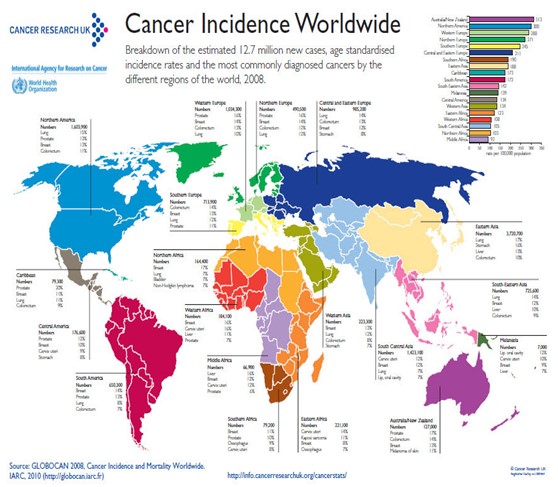
Figure 2.2: Epidemiology of cancer
(Source: De Carvalho et al. 2012)
Apart from that, the lifestyle in the developed as well as in the developing countries is not the trivial matters for inducing the prevalence of this disease. The consumption of the alcohols and chain smoking is quite common in these countries. Both the tobacco and cigarettes are actually composed of various carcinogenic substances which play as the promoter of cancer. Not only is that, the environmental pollution also the promoters of this disease. Thus, the respiratory cancer is quite common in the developing and developed countries and has shifted from the minor to the major component that is causing the mortality by the cancer. In addition, obesity, reproductive factors and genetic susceptibility are other potential factors in this regard. As a matter of fact, all these factors are responsible for inducing the oncogenes in the human body. Viruses, parasites as well as the radiations and chemicals are the originator of the oncogene activation. This oncogene in a specific body part has the enough potential to activate other additional oncogenes throughout the different parts of the body which, in turn, is transformed to the malignant stage of cancer (De Carvalho et al. 2012).
The primary prevention of the epidemiology of cancer is definitely the tobacco controlling, educating people about the proper lifestyle (diet, sexual life, sun exposure) and obviously hepatitis B vaccination which are supposed to be increasing the death toll from the cancer day-by-day. The screening and the early diagnosis has the stages such as surgery, radiotherapy and the chemotherapy (including consumption of essential drugs such as Aspirin). Palliative care is also proved to be a measure to address the drastic situation cancer epidemic across the world. Steps such as pain relief, symptom management, home care, and terminal care and of Assignment improved quality of the life are enable to manage and mitigate the risk of cancer to a large extent (Kaneda et al. 2012).
2.8 Advantages and disadvantages of using Aspirin in cancer diagnosis
Advantages
Aspirin is beneficial in many respects which led the doctors to prescribe this drug randomly in the treatment of cancer. The efficacy of this drug is visible because it enables to lower the risks of heart attacks and stroke. The underneath reason behind the efficiency of Aspirin is that it helps to reduce the clot of the blood which is beneficial for reducing the scope of heart attack. As a matter of fact, regular consumption of this drug with the suggested concentration by the doctors has proved to be reinforcing the cure of the breast cancer and the colorectal cancer. The intake of Aspirin is also fruitful in other cancers such as pancreatic, ovarian and melanoma cancers (Garcia-Albeniz and Chan, 2011).
Disadvantages
As evident from the clinical researches, the blood clotting is significantly reduced by the consumption of Aspirin. This implies that the tendency of bleeding is increased considerably due to the intake of this drug on a regular basis. Thus, cancer patients who have other diseases with high risk of bleeding (as for example, gastrointestinal disease), the intake of this drug is life-threatening because it may lead to the hemorrhagic stroke (Li et al. 2015).
2.9 Effectivity of Aspirin in treating cancer
As evident from the clinical researches, the risk of cancer can be reduced many folds by the intake of Aspirin on regular basis. However, the efficacy is mostly dependent on the concentration of this drug rather on the longevity of consumption. The curing report of the colorectal cancer (high COX-2 expression) and the breast cancer is most significant from the intake of this drug. As evident, the activities of the COX-2 enzyme are inhibited to a large extent by the administering of Aspirin on the patients suffering from colorectal cancer. Apart from that, the risk of developing other cancers such as the pancreatic cancer is also commendable in this regard. The survival from the cancer can be increased up to 20% from the use of Aspirin. Apart from that, prolonged intake of this drug in low dose may enable the patient to stop the spreading of this fatal disease (Diakos et al. 2014).
Chapter 3: Methodology
3.1: Introduction
In this chapter of the research paper the methods that are applied in order to make the data analysis of the research work more viable are elaborated in brief. In this chapter brief description related to the research philosophy, design and approach is included in order to elaborate the procedure of research work. Moreover the data analysis technique along with ethical consideration is included in this chapter.
3.2 Research onion
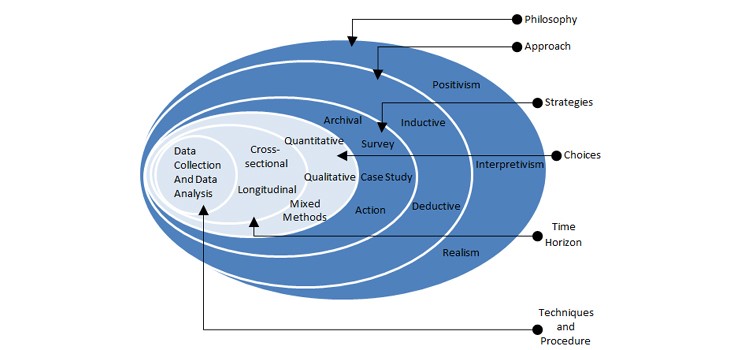
Figure 3.1: Research onion
(Source: Flick, 2015)
3.3 Research philosophy
In order to make the research more rational positivism philosophy is applied in this research paper. This is because positivism philosophy applies the native reasoning in order to make the research work more viable. Additionally positivism philosophy includes the data related from different relevant resources in a research work. Thus this philosophy helps to make the research paper more instructive (Kothari, 2004). The application of the natural reasoning in positivism philosophy provides logical justification of each findings of the research work. Thus the application of positivism philosophy makes the research work more legitimate.
3.4 Research design
In this research paper the exploratory research design is applied in order to make proper analysis of the data and to find out impact of the aspirin on cancer effectively. Application of exploratory design also helps to make the research work more flexible because exploratory research design helps to develop proper and effective way out to solve the problems (Saunders, Lewis and Thornhill, 2009). In order to make a research work more effective exploratory research design finds out the barrier of the problems related to the topic. Moreover explanatory research design helps to provides description related to the research variable more specifically. Thus application of the explanatory research work helps to make the research work more unique.
3.5 Research approach
The main flaws related to the inductive research approach are this application of this research approach is time consuming and it also has the risk related negative and worthless outcome. This is because inductive approach relies on deducing new theories from the research work. Thus any kind of mistake during the research work can make negative impact on the deduced theories hence can make the research work worthless. In this research work thus deductive research approach is tested (Yin, 2013). Deductive type research approach helps to make proper comparison between the outcomes of the research work with other related to research work. This is because in order to reach at a conclusion deductive research approach investigates the justification of different well known theories. Application of different theories which are logically proved makes the research work more decent. Thus deductive research approach proves the authenticity of this research work and enhances the quality of this research work.
3.6 Research strategy
In order to enhance the authenticity of the data which are included in this research work secondary qualitative and quantitative based research strategy is adopted in this research work. Secondary quantitative based analysis helps to include the knowledge of other relevant research works in this research paper. Thus the application of the secondary research strategy makes this research work more viable and credible (Flick, 2015).
The current research is based on the Meta analysis of the secondary research data. Meta analysis is effective in this process because this use of Meta analysis of data derived from different previous researches allowed the researcher to come to an appropriate conclusion about the effectivity of aspirin on treating cancer. It even helped the researcher to elaborate the topic going in-depth on the impact of aspirin on different kinds of cancer.
3.7 Data collection method
In this research work secondary data collection method is applied. Application of the secondary data collection method has reduced the time duration of the research work. This is because the data from different sources can easily collected and required less time than the primary method of data collection. Moreover the application of secondary data collection method increases the informative feature of the research work (Yin, 2013). This is because data are collected from different sources in secondary research method and thus many data related to the field can be included in a research work. Moreover authentic sources of data make the research work more feasible and hence increase the viability of the research work (Flick, 2015).
For the Meta analysis data collection initially 120 journals were chosen from the NCBI PubMed database and the British medical journal. Based on the inclusion and exclusion criteria out of the 120 journals 51 journals were chosen. On further assessment only 19 journals were chosen which were used to conduct the research. The inclusion criteria include journals from 2010 to 2018 and the journals relevant to the topic. In addition the included research papers are from well known journals with high impact factor. From the 51 research papers chosen the research papers with primary research are further used to complete the research (Kothari, 2004).
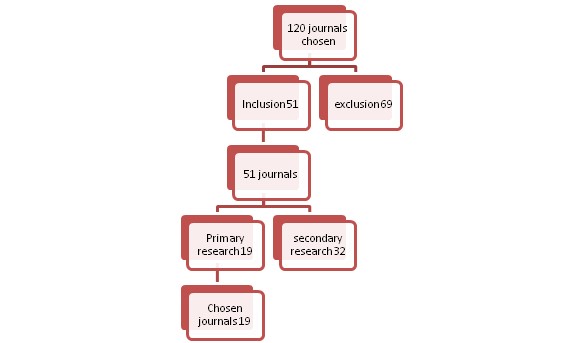
Figure 3.2: Meta analysis steps
(Source- created by author)
3.8 Data type
In this research work mainly quantitative data from different research papers are used. Statistical calculation has been included in this research paper on the basis of the quantitative data. The qualitative data have included proper theory based analysis in this research paper. The data are mainly included based on the three chosen variables. The three variables are the mortality rate of cancer patients, the concentration of administration of aspirin and the duration of administration of aspirin (Saunders, Lewis & Thornhill, 2009).
3.9 Data analysis technique
In order to make the research more analytical and in order to determine proper percentage of Aspirin which can help to prevent the mortality related to cancer linear regression technique is applied. The main beneficial feature of linear regression is this statistical tool can help to make proper graphical relationship between two variables of a research paper which are mortality rate, duration of the aspirin administration and the aspirin dosage. In order to distinguish different sets of observation ANOVA method is applied. ANOVA helps to make proper analysis of the variance of the statistical analysis and helps to determine the differences between means of statistical analysis. In this research paper moreover the hypothetical analysis is also included in order to make the hypothetical test more accurate F-test is adopted in this research work (Yin, 2013). This test helps to determine the suitable model for the statistical analysis of data. The result of this test is fitted into the ANOVA analysis. In order to recognize the validity of this research work proper R-squared test is adopted in this research work. This test helps to determine the closeness of the data set to the regression line and establishes the relationship between two variables. This in turn helps to make proper evaluation of data set. Moreover in order to adjust the predictors related to the statistical analysis adjusted R- squared technique is applied in this research paper.
3.10 Validity of the data
Data from different sources has been included in this research paper which has increased the validity of the research work. These authors of these journals are renowned and popular for their contribution in this field which proves the validation of these data. Moreover the data obtained are from primary researchers thus this increases the validity of the research (Flick, 2015).
3.11 Ethical consideration
The data of this research paper is protected as per the UK’s Data Protection Act 1988. These data of research paper is stored in secured vault of the university to prevent data breaches (Saunders, Lewis & Thornhill, 2009).
Chapter 4: Data analysis and discussion
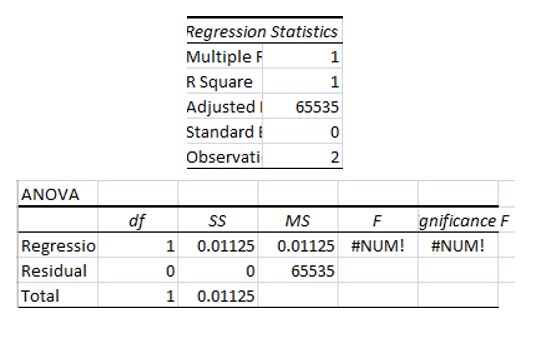
Figure 4.1: Breast cancer data
(Source: Created by author)
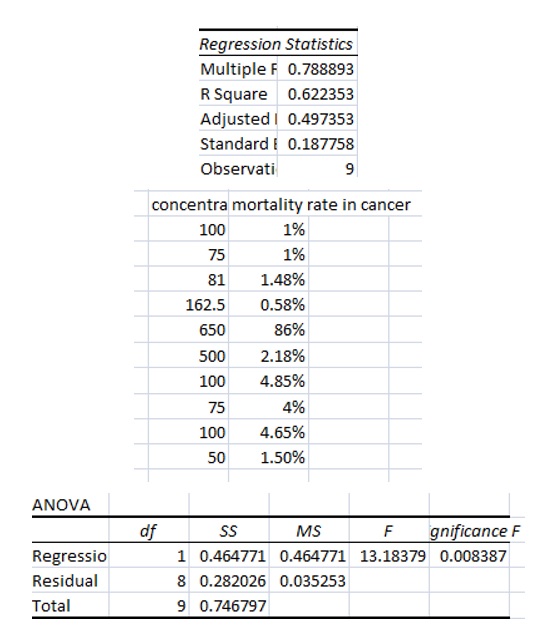
Figure 4.2: Interdependency between concentration of Aspirin and mortality rate
(Source: Created by author)
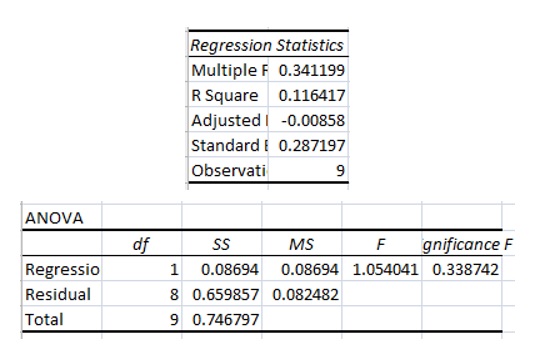
Figure 4.3: Years of exposure of Aspirin and mortality rate
(Source: Created by author)
4.1 Data analysis Hypothesis
H0: mortality rate in cancer is not dependent on the concentration of aspirin and they are mutually exclusive event
H1: increased concentration of aspirin leads to reduced mortality in cancer
The dependent variable in this case is the mortality rate of the cancer patients which is dependent on the concentration of aspirin and the duration of exposure of aspirin. Thus the formula will be:
Mortality rate = β0 + 𝛃c x concentrations of aspirin
H0: if βc= 0, there is no significant impact of aspirin on mortality rate
H1: if βc ≠ 0, then there is significant correlation between aspirin and mortality rate
H0: if βc> 0, there is positive impact of aspirin on mortality rate
H1: if βc < 0, then there is negative impact of aspirin on mortality rate
Mortality rate = β0 + 𝛃c x duration of aspirin
H0: if βc= 0, there is no significant impact of duration of exposure of aspirin on mortality rate
H1: if βc ≠ 0, then there is significant correlation between duration of exposure of aspirin and mortality rate
The results of the linear regression between the concentrations of aspirin and the mortality rate in cancer clearly depict the result that the multiple R value is 1. Thus this indicates that there is significant correlation between the mortality rate in breast cancer and the concentrations of aspirin. From the data obtained it can be seen that as the value of βc is not zero and is 0.39 thus indicates the acceptance of the alternative hypothesis and the rejection of the null hypothesis. This establishes the fact that there is correlation between aspirin concentration and the mortality rate in breast cancer patients. In addition as the value of βc is greater than 0 thus this establishes the fact that there is positive correlation between concentration of aspirin and the mortality rate in cancer patients. Thus from this linear regression of the breast cancer data it can be seen that with an increase in the aspirin concentration there is significant decline in the mortality rate of the cancer patients.
However as per the linear regression data obtained based on the general concentration of aspirin on different types of cancer it can be seen that the multiple R value is 0.7 which indicates that there is weak correlation and between the concentration of aspirin and the mortality rate. In addition here the βc is 0 thus indicating the fact that there is no relation between aspirin concentration and the mortality rate of cancer. This indicates the fact that although in breast cancer aspirin may be effective but in case of other forms of cancer aspirin may not be effective.
As per the linear regression of the variables aspirin administration duration and the mortality rate it can be seen that the multiple R value is 0.3 which indicates that the relation between the variables is not strong. In addition the βc value is also 0 which indicates that there is no relation between duration of administration of aspirin and the rate of mortality in cancer. Thus aspirin works in cancer irrespective of duration but is depended on the type of cancer.
4.2 Discussion
According to Rainsford (2016) it has been proved that an increased usage of Aspirin can decrease the mortality rate in case of cancer. This rate is dependent on the nature of the Aspirin used for treatment the cancers. Similarly the current research also proves that the cancer can be cured by the application of Aspirin. This proves that the application of aspirin can make significant positive effects in case of cancer. However According to Stacey (2013) Aspirin such as NASDIC cannot cure all kind of cancers. Aspirins like Ibuprofen, Naproxen has positive impact on collateral cancers. On the other hand in many cases of stomach cancer it has been noticed that the application of such Aspirin drugs like Ibuprofen, Naproxen is useless. Similarly regression data of this research also shows similar outcome and in this research it is also proved that the application of the Aspirin drugs provide positive impact in case of breast cancer and not in case of others. In many cases it has been observed that timely uses of Aspirin drugs like Ibuprofen can reduce the risk related to the breast cancer by 20%. Most of the cases of estrogen cancer doctors treated the patient with proper concentration of Aspirin. Many cases of HER2 negative breast cancer also can be cured by application of Naproxen with proper concentration. Thus there is a positive relationship between other research and this research paper. Although according to Thun et al. (2012) the application of Aspirin drugs in some cases of breast cancer and stomach cancer does not provide any kind of results in case of improper concentration. This is because improper concentration of Aspirin like Salicylates is not able to reduce the level growth level of cancer cell. It has been noted that the application of improper concentration of Aspirin cannot prevent colon polyps while the proper percentage is able to reduce the level of recurrent adenomas. It has been observed that by applying 325 mg salicylates can reduce the level of the cancerous cells of colon polyps. The application of proper concentration of the Aspirin can help to reduce the level of DCIS (Ductal carcinoma in situ). Similarly as per the research results obtained approximately 300 mg of Aspirin can help to reduce the breast cancer significantly. The application of 300mg Aspirin can make the mortality rate of cancer 3%. On the other hand it also has been observed that in case of DCIS use of improper concentration of Aspirin like 75 mg Salicylate can increase this mortality rate up to 30%. Thus it can be observed that proper and effective percentage of Aspirin can help to reduce the level of cancer where the application of improper percentage of Aspirin can make significant growth of the percentage of mortality. According to Chan and Cook (2012) the application of Aspirin for a long period actually does not have any impact in case of cancers. This has been observed that the mortality rate only depends upon the proper percentage of Aspirin.
In case of Adenoma it has been noted that the application of the improper concentration of the Aspirin cannot make any improvement on regular uses for a long time period. On the contrary with proper application of Naproxen (typically 325 mg per day for 2.6 years) can effectively reduce the level of cancerous cell at the secondary stage. Additionally it also has been observed that with the application of Salicylate 600 mg per day for 17 years long can reduce the level of Adenoma at the stage of FAP. Similar result can be found in this research paper in case of the duration of the application of Aspirin on the mortality rate. The primary research elaborates that the application of with improper concentration for 1 year can just reduce the level of mortality by 1%. This proves that there is no specific relationship between the time periods of the usage of Aspirin with the curability of cancer. Curability of cancer is only dependent on the concentration of the aspirin. This in turn proves that there is a positive relationship between research result analyses of this research paper with other relevant research papers. On the other hand according to Cao et al. (2016) in some specific cases like growth of cancerous cells in pancreatic duct can be cured with the application of the Aspirin drug like Naproxen for a long period of time. This also has been observed that with the application of the 325 mg to 1200 mg Aspirin at the daily basis for a long time period can reduce the growth rate of pancreatic cancer sustainably. This application depends on the time period not on the concentration of Aspirin. This shows that in some cases mortality rate and uses of Aspirin depends upon the time period. This directly opposes the findings of the statistical outcome of this research work. Although this type of exception can be seen in few cases of cancer this statement has not any relationship with this research work.
Chapter 5: Conclusion
Hence, it can be concluded that the Aspirin is proved to a life-saving drug that has innumerable presence in the treatment of the cancer patients. In addition from the research it can be seen that aspirin is effective in case of malignant cancer. Although this is not proved statistically but previous literatures points out this fact. The death toll can be potentially reduced by the proposed application of this drug in the treatment of the cancer. As a matter of fact, the colorectal cancer and the breast cancer are mostly benefited by the intake of this drug. The drug has to be consumed with the proper guidance of the doctors or the oncologists. As evident, a low-dose intake of this drug for a prolonged period in beneficial for reducing the life risk from this fatal disease. However, as a matter of fact, only the breast cancer is seen to be benefitted from the intake of this drug from this research. The proper concentration is believed to be beneficial for keeping aloof from the breast cancer. However, other forms of cancer not much dependent on the intake of Aspirin.
Reference List
Books
Flick, U., 2015. Introducing research methodology: A beginner's guide to doing a research project. Sage Publication: United States
Heim, S. and Mitelman, F., 2015. Cancer cytogenetics: chromosomal and molecular genetic aberrations of tumor cells. John Wiley & Sons: New Jersey
Kothari, C. R., 2004. Research Methodology: Methods and techniques. New Age International: India
Rainsford, K.D. ed., 2016. Aspirin and related drugs. CRC Press: Florida
Saunders, M. L., Lewis, P. Thornhill, A., 2009. Research methods for business students, 4.
Stacey, J., 2013. Teratologies: A cultural study of cancer. Routledge: Abingdon
Yin, R. K., 2013. Case study research: Design and methods. Sage publications: United States
Journals
Alfonso, L., Ai, G., Spitale, R.C. and Bhat, G.J., 2014. Molecular targets of aspirin and cancer prevention. British journal of cancer, 111(1), pp.61.
Axelrad, J., Lichtiger, S. and Yajnik, V., 2016. Inflammatory bowel disease and cancer: The role of inflammation, immunosuppression, and cancer treatment. World Journal of Gastroenterology, 22(20), pp.4794.
Bastiaannet, E., Sampieri, K., Dekkers, O.M., De Craen, A.J.M., van Herk-Sukel, M.P.P., Lemmens, V., Van Den Broek, C.B.M., Coebergh, J.W., Herings, R.M.C., Van De Velde, C.J.H. and Fodde, R., 2012. Use of aspirin postdiagnosis improves survival for colon cancer patients. British journal of cancer, 106(9), pp.1564-1570.
Bosetti, C., Rosato, V., Gallus, S., Cuzick, J. and La Vecchia, C., 2012. Aspirin and cancer risk: a quantitative review to 2011. Annals of Oncology, 23(6), pp.1403-1415.
Burr, N., Hull, M. and Subramanian, V., 2016. Does aspirin or non-aspirin non-steroidal anti-inflammatory drug use prevent colorectal cancer in inflammatory bowel disease?. World Journal of Gastroenterology, 22(13), pp.3679.
Burrell, R.A., McGranahan, N., Bartek, J. and Swanton, C., 2013. The causes and consequences of genetic heterogeneity in cancer evolution. Nature, 501(7467), pp.338.
Cao, Y., Nishihara, R., Wu, K., Wang, M., Ogino, S., Willett, W.C., Spiegelman, D., Fuchs, C.S., Giovannucci, E.L. and Chan, A.T., 2016. Population-wide impact of long-term use of aspirin and the risk for cancer. JAMA oncology, 2(6), pp.762-769.
Chan, A.T. and Cook, N.R., 2012. Are we ready to recommend aspirin for cancer prevention?. Lancet (London, England), 379(9826), pp.1569-1571.
Chia, W.K., Ali, R. and Toh, H.C., 2012. Aspirin as adjuvant therapy for colorectal cancer—reinterpreting paradigms. Nature reviews Clinical oncology, 9(10), pp.561.
Choe, K.S., Correa, D., Jani, A.B. and Liauw, S.L., 2010. The use of anticoagulants improves biochemical control of localized prostate cancer treated with radiotherapy. Cancer, 116(7), pp.1820-1826.
Cui, X.J., He, Q., Zhang, J.M., Fan, H.J., Wen, Z.F. and Qin, Y.R., 2014. High-dose aspirin consumption contributes to decreased risk for pancreatic cancer in a systematic review and meta-analysis. Pancreas, 43(1), pp.135-140.
Curiel-Lewandrowski, C., Nijsten, T., Gomez, M.L., Hollestein, L.M., Atkins, M.B. and Stern, R.S., 2011. Long-term use of nonsteroidal anti-inflammatory drugs decreases the risk of cutaneous melanoma: results of a United States case–control study. Journal of Investigative Dermatology, 131(7), pp.1460-1468.
De Carvalho, D.D., Sharma, S., You, J.S., Su, S.F., Taberlay, P.C., Kelly, T.K., Yang, X., Liang, G. and Jones, P.A., 2012. DNA methylation screening identifies driver epigenetic events of cancer cell survival. Cancer cell, 21(5), pp.655-667.
Diehl, A., 2012. Individual-patient meta-analysis: Daily aspirin reduces risk for incident cancer with distant metastasis. Annals of Internal Medicine, 157(2), pp.JC1.
Dossus, L., Allen, N., Kaaks, R., Bakken, K., Lund, E., Tjonneland, A., Olsen, A., Overvad, K., Clavel‐Chapelon, F., Fournier, A. and Chabbert‐Buffet, N., 2010. Reproductive risk factors and endometrial cancer: the European Prospective Investigation into Cancer and Nutrition. International Journal of Cancer, 127(2), pp.442-451.
Drew, D., Cao, Y. and Chan, A., 2016. Aspirin and colorectal cancer: the promise of precision chemoprevention. Nature Reviews Cancer, 16(3), pp.173-186.
Elwood, P., Morgan, G., Pickering, J., Galante, J., Weightman, A., Morris, D., Kelson, M. and Dolwani, S., 2016. Aspirin in the Treatment of Cancer: Reductions in Metastatic Spread and in Mortality: A Systematic Review and Meta-Analyses of Published Studies. PLOS ONE, 11(4), pp.0152402.
Fowkes, F. et. al., 2011. Aspirin for Prevention of Cardiovascular Events in a General Population Screened for a Low Ankle Brachial Index: A Randomized Controlled Trial. Journal of Vascular Surgery, 53(4), pp.1158.
Gerstein, N.S., Schulman, P.M., Gerstein, W.H., Petersen, T.R. and Tawil, I., 2012. Should more patients continue aspirin therapy perioperatively?: clinical impact of aspirin withdrawal syndrome. Annals of surgery, 255(5), pp.811-819.
Holmes, M.D., Chen, W.Y., Li, L., Hertzmark, E., Spiegelman, D. and Hankinson, S.E., 2010. Aspirin intake and survival after breast cancer. Journal of clinical oncology, 28(9), p.1467.
Lema, M.J., Foley, K.M. and Hausheer, F.H., 2010. Types and epidemiology of cancer-related neuropathic pain: the intersection of cancer pain and neuropathic pain. The oncologist, 15(Supplement 2), pp.3-8.
Liao, X., Lochhead, P., Nishihara, R., Morikawa, T., Kuchiba, A., Yamauchi, M., Imamura, Y., Qian, Z.R., Baba, Y., Shima, K. and Sun, R., 2012. Aspirin use, tumor PIK3CA mutation, and colorectal-cancer survival. New England Journal of Medicine, 367(17), pp.1596-1606.
Linehan, W.M., Srinivasan, R. and Schmidt, L.S., 2010. The genetic basis of kidney cancer: a metabolic disease. Nature reviews urology, 7(5), pp.277.
Marcus, D.A., 2011. Epidemiology of cancer pain. Current pain and headache reports, 15(4), pp.231-234.
Pan, S.Y. and Morrison, H., 2011. Epidemiology of cancer of the small intestine. World journal of gastrointestinal oncology, 3(3), pp.33.
Rothwell, P.M., Fowkes, F.G.R., Belch, J.F., Ogawa, H., Warlow, C.P. and Meade, T.W., 2011. Effect of daily aspirin on long-term risk of death due to cancer: analysis of individual patient data from randomised trials. The Lancet, 377(9759), pp.31-41.
Rothwell, P.M., Price, J.F., Fowkes, F.G.R., Zanchetti, A., Roncaglioni, M.C., Tognoni, G., Lee, R., Belch, J.F., Wilson, M., Mehta, Z. and Meade, T.W., 2012. Short-term effects of daily aspirin on cancer incidence, mortality, and non-vascular death: analysis of the time Assignment of risks and benefits in 51 randomised controlled trials. The Lancet, 379(9826), pp.1602-1612.
Rumyantsev, S., 2010. Hypothesis: Towards the origin of cancer epidemics and pathogenesis. Journal of carcinogenesis, 9.
Seyfried, T.N. and Shelton, L.M., 2010. Cancer as a metabolic disease. Nutrition & metabolism, 7(1), pp.7.
Thorat, M.A. and Cuzick, J., 2013. Role of aspirin in cancer prevention. Current oncology reports, 15(6), pp.533-540.
Thun, M.J., Jacobs, E.J. and Patrono, C., 2012. The role of aspirin in cancer prevention. Nature reviews Clinical oncology, 9(5), pp.259.
Timp, J.F., Braekkan, S.K., Versteeg, H.H. and Cannegieter, S.C., 2013. Epidemiology of cancer-associated venous thrombosis. Blood, 122(10), pp.1712-1723.
Zhang, Y., Liu, L., Fan, P., Bauer, N., Gladkich, J., Ryschich, E., Bazhin, A.V., Giese, N.A., Strobel, O., Hackert, T. and Hinz, U., 2015. Aspirin counteracts cancer stem cell features, desmoplasia and gemcitabine resistance in pancreatic cancer. Oncotarget, 6(12), pp.9999.
Online articles
Chiba, T., Marusawa, H. and Ushijima, T., 2012. Inflammation-associated cancer development in digestive organs: mechanisms and roles for genetic and epigenetic modulation. Gastroenterology, 143(3), pp.550-563 [Online]. Available from:http://www.travelmedicinejournal.com/article/S0016-5085(12)00957-2/abstract [Accessed on: 23/01/2018].
Diakos, C.I., Charles, K.A., McMillan, D.C. and Clarke, S.J., 2014. Cancer-related inflammation and treatment effectiveness. The Lancet Oncology, [online], 15(11), pp.e493-e503 [Online]. Available from: https://www.sciencedirect.com/science/article/pii/S1470204514702633 [Accessed on: 23/01/2018].
Garcia-Albeniz, X. and Chan, A.T., 2011. Aspirin for the prevention of colorectal cancer. Best practice & research Clinical gastroenterology, 25(4-5), pp.461-472. https://www.sciencedirect.com/science/article/pii/S152169181100103X
Grivennikov, S.I., Greten, F.R. and Karin, M., 2010. Immunity, inflammation, and cancer. Cell, 140(6), pp.883-899 [Online].. Available from:https://www.sciencedirect.com/science/article/pii/S0092867410000607 [Accessed on: 18/1/2018].
Kaneda, A., Matsusaka, K., Aburatani, H. and Fukayama, M., 2012. Epstein–Barr virus infection as an epigenetic driver of tumorigenesis. Cancer research, 72(14), pp.3445-3450 [Online]. Available from: http://cancerres.aacrjournals.org/content/72/14/3445.short [Accessed on: 18/1/2018].
Li, P., Wu, H., Zhang, H., Shi, Y., Xu, J., Ye, Y., Xia, D., Yang, J., Cai, J. and Wu, Y., 2015. Aspirin use after diagnosis but not prediagnosis improves established colorectal cancer survival: a meta-analysis. Gut, 64(9), pp.1419-1425 [Online]. Available from: http://gut.bmj.com/content/64/9/1419.short [Accessed on: 18/1/2018].
Martinez, V.D., Vucic, E.A., Becker-Santos, D.D., Gil, L. and Lam, W.L., 2011. Arsenic exposure and the induction of human cancers. Journal of toxicology, 2011 [Online]. Available from: https://www.hindawi.com/journals/jt/2011/431287/abs/ [Accessed on: 18/1/2018]
Mesri, E.A., Feitelson, M.A. and Munger, K., 2014. Human viral oncogenesis: a cancer hallmarks analysis. Cell host & microbe, 15(3), pp.266-282 [Online]. Available from: https://www.sciencedirect.com/science/article/pii/S1931312814000699 [Accessed on: 18/1/2018].
Sutcliffe, P., Connock, M., Gurung, T., Freeman, K., Johnson, S., Kandala, N.B., Grove, A., Gurung, B., Morrow, S. and Clarke, A., 2013. Aspirin for prophylactic use in the primary prevention of cardiovascular disease and cancer: a systematic review and overview of reviews. Health technology assessment (Winchester, England), 17(43), pp.1[Online]. Available from: https://www.ncbi.nlm.nih.gov/pmc/articles/PMC4781046/ [Accessed on: 18/1/2018].
Zhao, J., Wu, G., Bu, F., Lu, B., Liang, A., Cao, L., Tong, X., Lu, X., Wu, M. and Guo, Y., 2010. Epigenetic silence of ankyrin‐repeat–containing, SH3‐domain–containing, and proline‐rich‐region–containing protein 1 (ASPP1) and ASPP2 genes promotes tumor growth in hepatitis B virus–positive hepatocellular carcinoma. Hepatology, 51(1), pp.142-153 [Online]. Available from: https://aasldpubs.onlinelibrary.wiley.com/doi/full/10.1002/hep.23247 [Accessed on: 18/1/2018].


